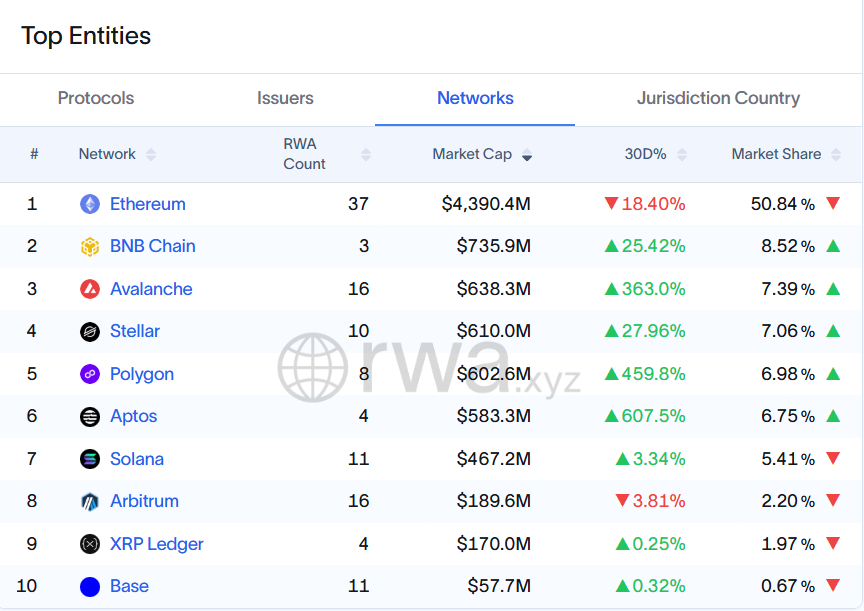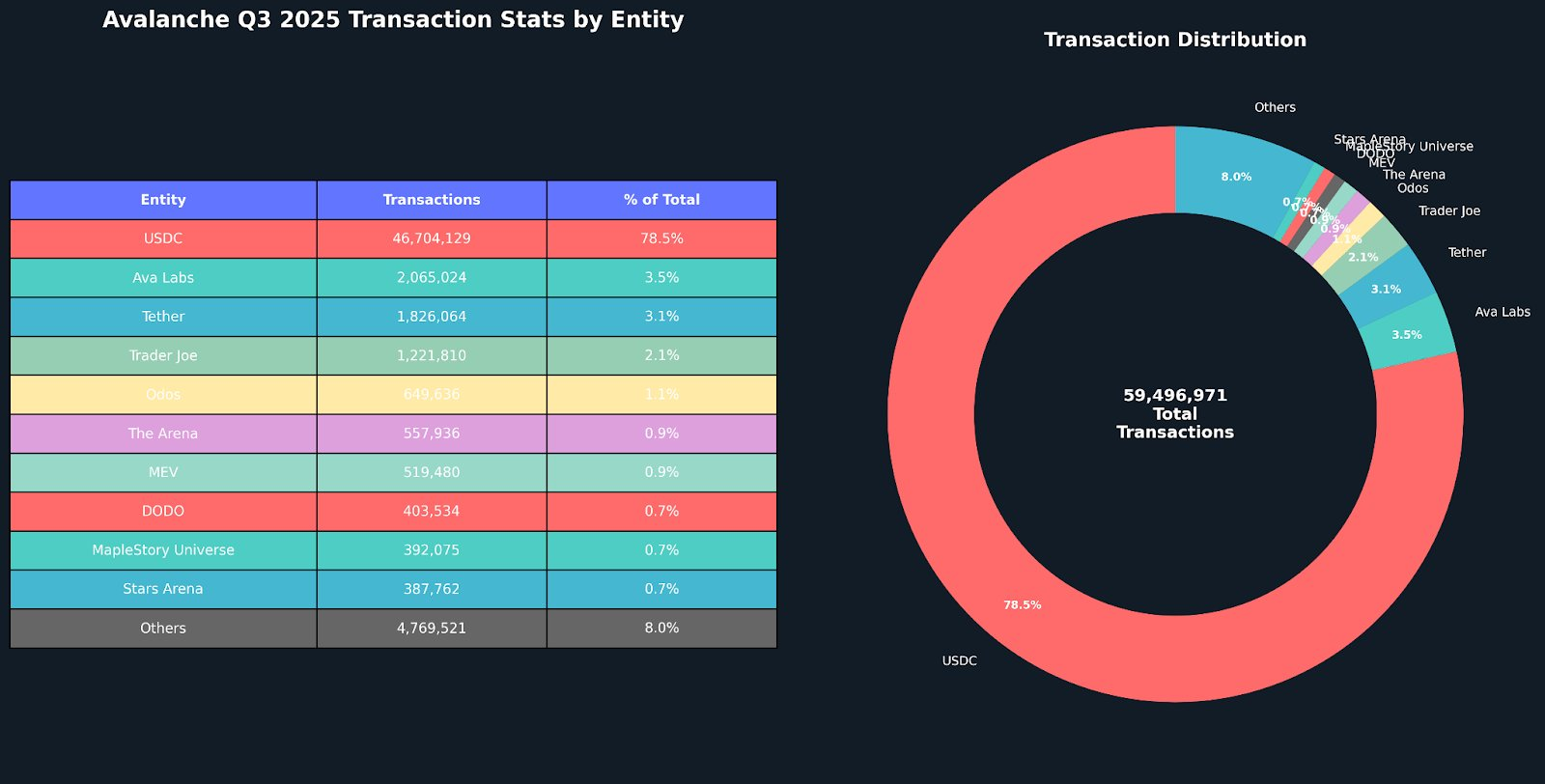Institutions are tokenizing hundreds of millions in assets on the Avalanche blockchain, transforming government and traditional finance integrations into onchain reality, as highlighted by analytics firm Nansen. This surge includes government-backed stablecoins and tokenized Treasurys, boosting accessibility and efficiency in DeFi.
-
Avalanche leads in tokenized US Treasurys with $638 million onchain, ranking third behind BNB Chain and Ethereum.
-
Governments like Wyoming’s Stable Token Commission have launched the FRNT stablecoin on Avalanche and other networks, marking increased public sector adoption.
-
Despite network growth with over 1 million daily transactions, AVAX trades 86% below its all-time high of $146, currently at around $19.66 amid market volatility.
Institutional adoption surges on Avalanche blockchain as firms tokenize $300 million in capital and governments issue stablecoins. Discover key trends and onchain innovations driving this shift. Stay ahead in crypto—explore now for investment insights.
What is Driving Institutional Adoption on the Avalanche Blockchain?
Avalanche blockchain is rapidly becoming a hub for institutional investors and governments due to its high-speed transactions and scalability, enabling seamless tokenization of real-world assets. In recent quarters, entities like SkyBridge Capital have committed to tokenizing $300 million in hedge fund capital on the network, while Wyoming’s government launched the Frontier Stable Token (FRNT) as a fully collateralized stablecoin backed by US dollars and short-duration Treasury bills. This development underscores Avalanche’s role in bridging traditional finance with decentralized ecosystems, providing enhanced liquidity and accessibility for tokenized assets.
How Are Tokenized US Treasurys Enhancing Liquidity on Avalanche?
Tokenized US Treasurys on the Avalanche blockchain represent a significant portion of the real-world asset (RWA) tokenization trend, with $638 million in value locked as of the end of the third quarter, according to data from RWA.xyz. These digital representations of government securities are minted onchain to democratize access, allowing 24/7 trading and fractional ownership that traditional markets cannot offer. By integrating with DeFi protocols, they unlock new yield opportunities; for instance, investors can use them as collateral for loans or liquidity provision, reducing settlement times from days to seconds. Analytics from Nansen further illustrate this momentum, noting Avalanche’s position as the third-largest blockchain for such assets after BNB Chain and Ethereum. This growth not only bolsters network security through increased economic activity but also attracts institutional players seeking compliant, efficient alternatives to legacy systems. Experts emphasize that tokenized Treasurys could represent trillions in future value, with Avalanche’s subnet architecture providing customized compliance layers for regulated entities.

Top blockchains by tokenized US Treasurys. Source: RWA.xyz
The rise in tokenized assets aligns with broader institutional interest, as seen in SkyBridge Capital’s pledge led by Anthony Scaramucci. Nansen describes this as “quietly turning TradFi and gov tech into onchain reality,” highlighting how Avalanche’s infrastructure supports complex financial instruments without compromising speed or cost-efficiency.

Source: Nansen
Avalanche’s appeal extends to public sector applications, with Wyoming’s FRNT stablecoin requiring a 102% reserve backed by cash and Treasurys, ensuring stability and trust. This initiative, issued on Avalanche alongside six other public blockchains, demonstrates how governments are leveraging the network for transparent, auditable digital currencies. Such integrations foster innovation in areas like cross-border payments and fiscal policy execution, positioning Avalanche as a compliant gateway for sovereign digital assets.
Frequently Asked Questions
What is the FRNT Stablecoin and Its Role on the Avalanche Blockchain?
The Frontier Stable Token (FRNT) is Wyoming’s first government-backed stablecoin, launched on the Avalanche blockchain and other networks to provide a secure, US dollar-pegged digital asset. Fully collateralized with a 102% reserve of cash and short-term US Treasurys, it aims to enhance financial inclusion and efficiency in public transactions, as reported in August by Cointelegraph. This pegged token supports seamless onchain operations while adhering to stringent regulatory standards.
Why Has AVAX Price Lagged Despite Avalanche Blockchain Growth?
AVAX, the native token of the Avalanche blockchain, has declined 86% from its 2021 all-time high of $146, trading around $19.66 recently due to broader market pressures like a $19 billion liquidation event in early October tied to US trade policy shifts. Despite averaging over 1 million daily transactions with peaks at 51.6 million, token price often decouples from network metrics in volatile crypto environments, focusing investor attention on utility over speculation.

Source: Nansen
Onchain metrics reveal robust activity, yet external factors such as global economic uncertainty and tariff threats have dampened sentiment across cryptocurrencies. Analysts from Nansen point to sustained transaction volumes as a foundation for long-term value accrual, even as short-term price movements reflect market-wide corrections.
Key Takeaways
- Government Integration: Wyoming’s FRNT stablecoin launch on Avalanche highlights growing public sector trust in blockchain for stable, backed digital assets, paving the way for broader fiscal applications.
- Institutional Tokenization: Commitments like SkyBridge Capital’s $300 million pledge underscore Avalanche’s efficiency in handling TradFi assets, with tokenized Treasurys reaching $638 million per RWA.xyz data.
- Network Resilience: Over 1 million daily transactions signal strong adoption, advising investors to monitor onchain growth amid AVAX’s current undervaluation relative to utility.
Conclusion
The Avalanche blockchain is solidifying its position as a leader in institutional and governmental tokenization, with tokenized US Treasurys and stablecoins like FRNT driving onchain innovation and liquidity. As Nansen notes, this trend is making DeFi truly institutional, bridging TradFi gaps through scalable infrastructure. Looking ahead, continued adoption could catalyze further growth in real-world asset sectors, offering opportunities for investors to engage with compliant, high-yield digital economies—consider exploring Avalanche’s ecosystem for strategic positioning in the evolving crypto landscape.
